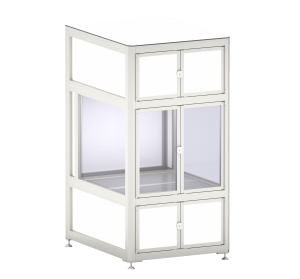How to meet the combined challenge of achieving cleanroom conditions while also complying with ESD safety requirements.
In certain sectors, the production and further processing of sensitive electronic components takes place in cleanrooms. The electronics industry, wafer and chip manufacturing, and microsystems engineering are just a few examples. This throws up a twofold challenge for companies – components not only need to be protected against contamination, but also against uncontrolled electrostatic discharge (= ESD). A combination of cleanroom conditions and ESD safety is therefore called for. Let’s start with the cleanroom, where the particle count must be kept as low as possible. This is the only way to avoid contaminating highly sensitive processes. Special air-cleaning filters are used for this purpose, while a slight overpressure stops particles getting into cleanrooms from outside. Particles aren’t the only risk when manufacturing sensitive components, though.
ESD – an uncontrolled equalisation of electrical charges between two objects charged with different voltages – can also cause a great deal of damage. It is mostly friction that causes components to become electrostatically charged. One particularly problematic aspect is that electrostatic discharge can occur even without any direct contact. Even relatively low discharge voltages of 100 volts are sufficient to damage integrated circuits (ICs). Electrostatic charges can quickly reach several tens of thousands of volts, though, so they must be dissipated to the earth in a controlled manner whenever they occur. If you manufacture ESD-sensitive components (or are planning to), you must put ESD safety measures in place and limit the particle count in the room to a certain level. We have extensive expertise in ESD safety and cleanroom production, and we are in continuous dialogue with specialist partners and experts from both these areas. Join us for an introduction to this specialised topic, combining the two areas.

Cleanroom solutions, including protection against ESD
Use the modular design principle to create safe cleanroom solutions that also eliminate ESD. item will help you implement your envisaged solution in exactly the dimensions required.
Dangers of ESD and requirements relating to ESD-safe workstations
One particular danger of ESD is that ESD damage is not immediately obvious during the final inspection in most cases. Such damage is often only noticed once it is too late – when the components have already been installed in the end product. Weaknesses that go undetected frequently cause malfunctions or can even go on to result in a breakdown during operation. Whatever the circumstances, rectifying the damage has serious and costly repercussions – it can lead to complaints, extensive replacement campaigns and a loss of customer trust. You should therefore take detailed precautions. DIN EN 61340-5-1 compliance is an integral part of comprehensive ESD safety. Besides wearing appropriate protective clothing, all relevant staff must also receive training. ESD safety measures also include setting up an electrostatic protected area (EPA).
Particular attention should be paid to the table top. Besides the material’s volume conductivity, its suitability is also ensured in cleanroom environments, in accordance with the relevant standards.
From clothing and equipment to other components, all materials in an EPA need to be electrostatically dissipative and earthed to the same potential. This involves dissipating different charges via an earthing connection. Products thus remain undamaged. Special requirements also apply to workstations located within an EPA. In this way, you can specifically avoid electrostatic charges and differences in potential. ESD-safe workstations located in cleanrooms are naturally also subject to special stipulations. The work bench is vitally important in this regard. “item carries out detailed testing on work benches for use in electrostatic protected areas and also on other equipment prior to delivery, and it attests to their safety by including a measurement record,” says work bench expert Marius Geibel, a Product Manager at item. “Particular attention should be paid to the table top. Besides the material’s volume conductivity, its suitability is also ensured in cleanroom environments, in accordance with the relevant standards,” he adds.
Components and accessories for ESD safety
ESD safety goes beyond the table top. You should also ensure that uprights and accessories meet the necessary guidelines. To achieve end-to-end ESD safety, for example, it is necessary to comply with the defined discharge resistance and surface resistance limits. If charges do build up, they must not dissipate too quickly – otherwise, components could be damaged. “Especially in the case of moving components, the discharge resistance to earth must be adequate. Articulations must not have an insulating action. That’s why item pivot arms always have metallic contact,” explains Geibel. Anyone working at an ESD bench must wear an ESD Wristband. Wristbands of this kind are connected to the earth via a cable. As far as possible, this should also be the case for all other equipment. Generally speaking, the floor within an EPA must be dissipative to prevent different electrical potentials.

Specialist ESD safety expertise
From the basics of ESD and practical tips to setting up an EPA and user reports – expand your knowledge for free in the ESD Media Centre and find out everything you need to know about protecting electrostatically sensitive components.
Detailed ESD control program at item
“Before purchasing a new ESD work bench or other factory equipment, customers should insist on checking ESD safety,” emphasises Geibel. “For this purpose, we have established an ESD control program that ensures ESD safety – from the purchase of individual components through to delivery of the customised turnkey customer solution,” he adds. In this way, item makes sure the parts purchased offer protection against ESD. What’s more, trained specialist staff perform extensive measurements prior to delivery. You are then given an ESD record that proves your ESD work bench has been checked at the relevant ESD measuring points. Besides standard points such as the ESD table top and storage areas, additional points defined in consultation with you are also included. As a result, you can rely on the solution delivered being properly designed, complete with the correct discharge resistance values.
Designing ESD workstations online is easy and saves a lot of time
When planning an ESD-safe workstation, there are numerous aspects for you to consider – from a volume-conductive ESD table top and a conductive table frame to ESD-safe storage areas and relevant accessories such as hooks, holders and parts containers. Our Work Bench Configurator offers valuable assistance with this task. Benefit from a 3D view, intuitive drag-and-drop controls, smart functions and project documentation that is generated automatically. All this makes it quick and easy for you to design your ESD work bench. Customise the configuration of the bench, including equipment, or use preconfigured models.
The ESD measuring points are displayed directly at the planning stage for you and listed in the summary. We carry out precise discharge resistance measurements at these points.
The ESD measuring points are displayed directly at the planning stage for you and listed in the summary. As already mentioned, we carry out precise discharge resistance measurements at these points. Generally speaking, you should use benches that can be optimally adapted to production workflows and the physiology of employees. A design based on ergonomic principles offers a variety of benefits – you will provide better health protection for staff and help them concentrate better, which will also boost productivity. From ergonomic design and ESD safety to cleanroom solutions – the flexibility of item components means you can ensure ideally adapted and safe operating conditions.
Cleanroom conditions and protection against ESD – the modular principle makes it possible
Once they are installed, you must ensure the components of your ESD bench undergo regular checks, as stipulated in IEC 61340. Cleaning also plays a major role, removing contamination caused by humans or machines. Continual, proper cleaning is the only way to maintain protection against ESD. When manufacturing computer chips, semiconductors or sensors, there are additional safety aspects to consider. Depending on the process and/or product sensitivity, you may need to meet special requirements when it comes to cleanroom features. With the item Work Bench System and other flexible solutions from our product portfolio, you are ideally placed to do so. As a result, you can specifically tackle both challenges – ensuring ESD safety and creating cleanroom conditions. We are happy to help turn your ideas into reality with our modular building kit principle.
Are you interested in ESD safety and cleanroom solutions? Then we have something that’s right up your street! Simply subscribe to the item blog by completing the box at the top right.


